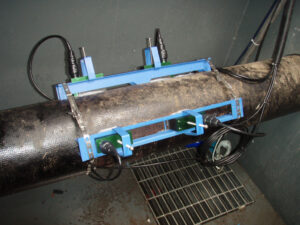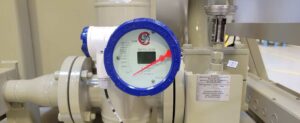Differential pressure flow meters are the workhorse of industrial flow measurement, relied upon for their versatility, accuracy, and affordability. This guide provides plant engineers, technicians, and instrumentation professionals a useful resource for selecting, installing, maintaining, and applying differential pressure flow meters for optimal performance.
How Differential Pressure Flow Meters Work
Differential pressure flow meters operate by measuring the pressure drop across a deliberately-placed flow restriction called a primary element. As fluid passes through the restriction, velocity increases and pressure decreases. This pressure difference, measured between the high and low sides, correlates to flow rate via the Bernoulli flow equation.
Common primary elements include orifice plates, venturi tubes, pitot tubes, wedge elements, cones, and nozzles. Each creates a unique pressure loss pattern based on parameters like pipe diameter, fluid properties, desired measurement range, and allowable permanent pressure loss. Meters come pre-calibrated by the manufacturer for specific primary element geometries.
Piezo-resistive pressure sensors continuously measure the static pressure before and after the restriction. The sensors must be kept free of vibration, debris, and moisture. Impulse tubing transmits the low level signals to an electronic transmitter. The transmitter amplifies the inputs, handles any temperature compensation, applies calibration factors, and converts the differential pressure into an analog or digital flow rate signal.
Key Specifications When Selecting a Meter
Choosing a differential pressure flow meter requires matching the meter’s capabilities to the requirements of the application. Critical specifications to consider include:
- Line size – Determines full scale flow and primary element design
- Fluid type – Liquid, gas, steam compatibility
- Maximum operating pressure – Pressure rating of body/flanges
- Temperature limits – Of the primary element, sensors, and transmitter
- Viscosity range – Higher viscosity fluids may require special considerations
- Accuracy and turndown ratio needed
- Maximum allowable permanent pressure loss
- Desired output – 4-20mA, HART, Profibus, Modbus
- Explosion-proof approvals – ATEX, IECEx, FM, etc.
Additional factors are pipe layout, straight run requirements, flow profile, and environmental conditions. Consulting manufacturers’ technical literature is recommended when selecting a meter.
Installation Best Practices
Meticulous installation is required to achieve rated meter accuracy and performance. Following these best practices:
- Observe the required upstream and downstream straight pipe run – certain types of primary elements, such as the orifice plate, require lengthy straight pipe runs in order to minimize turbulence and provide stable readings.
- Keep process connections compatible with pipe type and pressure rating.
- Position pressure taps according to manufacturer recommendations – this reduces flow disturbances.
- Mount transmitters close to sensors or use impulse tubing of equal length.
- Install block and bleed valves for in-situ zero checking and calibration.
- Use proper isolation gaskets, avoid over-tightening flange bolts.
- Verify pressure rating exceeds maximum line pressure.
- Ground per local electrical codes and the manufacturer’s instructions.
Proper installer training is highly recommended for large line size or critical applications.
Maintaining Peak Performance
Routine maintenance maximizes uptime and extends service life. Recommended tasks include:
- Inspecting transmitters, sensors, and connections for damage or leaks. Fix any impulse tubing blockages.
- Verifying proper function of isolation and equalization valves. Keep the internals clean.
- Checking for moisture or contaminants in impulse tubing. Clear or replace if necessary.
- Monitor differential pressure levels – clean/replace elements when permanent loss becomes excessive.
- Calibrate periodically using external references or perform user-defined input calibrations.
- Analyze diagnostics for preventive maintenance alerts.
- Exercise valves to avoid sticking. Lubricate moving parts.
- Inventory critical spare parts like gaskets, bolts, impulse tubing.
Developing a comprehensive maintenance plan tailored to the meter and application is strongly advised.
Typical Applications
The flexibility of differential pressure meters makes them suitable for an extremely diverse range of industrial flow applications. Typical uses include:
Oil & Gas – Wellhead monitoring, flare gas measurement, transmission pipelines
Water/Wastewater – Flow monitoring for treatment plants, lift stations, distribution systems
Power – Feedwater, condenser water, cooling water, steam flows, stack emissions
Chemical & Petrochemical – Production monitoring, blending/batching, loading rack measurement
Pulp & Paper – Digester flows, black liquor, steam flows, custody transfer
Food & Beverage – Ingredient batching, sanitary process lines, plant energy management
Pharmaceutical – Clean process liquids, transfers, batching
Metals & Mining – Slurry flows, pneumatic conveying lines
HVAC – Chilled water, hot water, steam, compressed air, ventilation balancing
And countless more. When accuracy, reliability, and affordability matter, differential pressure meters deliver for even the most demanding applications.
Conclusion
Differential pressure flow meters provide versatility, value, and trusted performance for mission-critical flow monitoring across every industry. By understanding the operating principles, selection factors, installation practices, maintenance needs, and diverse applications, flow instrumentation professionals can unlock the full potential of differential pressure flow measurement. Leverage this definitive guide to confidently apply differential pressure flow meters for optimal safety, efficiency, and productivity.





